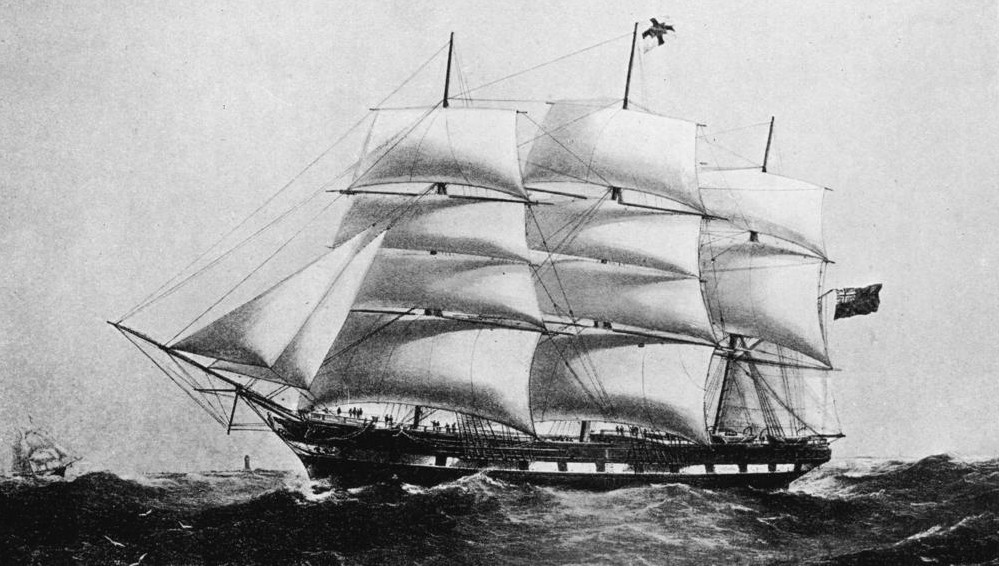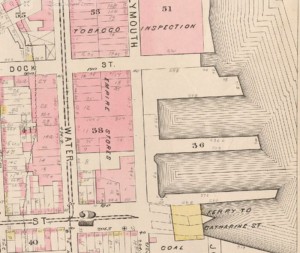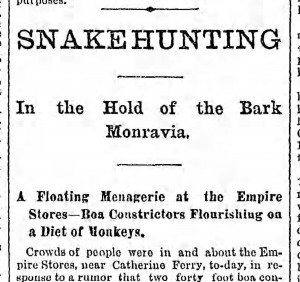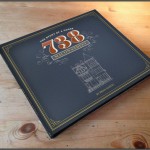THE RETURN SLAVE TRADE IN DUMBO (1889)

Back in the 19th century, newspapers knew how to tell a good yarn. And who better to get their material from than sailors who were known for spinning a few of their own.
So, in 1889, when reporters heard a rumor about a ship filled with escaped snakes and monkeys, many of the former making meals of many of the latter, they raced down to the shipyards to see what stories they could find.
THE CLIPPER SHIP MONROVIA AT THE EMPIRE STORES

The Monrovia’s original purpose was the Liberian trade, but as all shipping companies had to make up for costs in any way they could, they usually took on a trade in passengers. The clippers’s trade route was New York to Liberia, though, so there were few passenger sources other than missionaries – until they learned of the groups hoping to repatriate former slaves.

OUT OF AFRICA
On the date of her return to New York, the Monrovia was transporting in her holds palm oil, ginger, palm nuts, cattle hides, canewood, and coffee, the last of which, in particular, caused her to dock at Empire Stores.
She was also ferrying a number of disgruntled former black emigrants to Liberia who, after spending time on the Dark Continent, had realized that they were no longer suited to the environment.

But these passengers were to pass through another travail during their trip back. As their quarters were on the same level with the cargo, it was the members of the living cargo that began to terrify them.
For several weeks, these passengers would live as though they had taken the jungle with them.
BOA CONSTRICTORS FLOURISHING ON A DIET OF MONKEYS

“He kep’ ’em with a head on him as large as that barrel,” a red-shirted man who recounted his time below decks told a reporter, “and he had a timber of log-wood in his hand pickin’ his teeth. His teeth were about eight foot long on each jaw and I could see several monkeys’ tails sticking in them. He made a snap at me and I up the hoistin’ rope and I don’t go down again.”
A Health Inspector, an expert on snakes, “peered cautiously over the combings of the hatchway but dared go no further.”
“There is an ad valorum duty of 20 per cent. on monkeys,” ended the frustrated reporter’s yarn, “and the government will be cheated if they can’t find out how many are imported inside the snakes.”
———————————————————————————————————————–
 The story you just read was composed from historical research performed by The Brownstone Detectives. Allow us to do an in-depth investigation of your house and its former owners and produce your very own House History Book. Your hardbound coffee table book will include an illustrated and colorful narrative timeline that will bring the history of your house to life. Contact us today.
The story you just read was composed from historical research performed by The Brownstone Detectives. Allow us to do an in-depth investigation of your house and its former owners and produce your very own House History Book. Your hardbound coffee table book will include an illustrated and colorful narrative timeline that will bring the history of your house to life. Contact us today.